My fifteenth farm was Singing River Farm in Rockingham, Vermont.
The Farm
The farmers are Steve and Laurel. Steve grew up in Vermont and Laurel is from Oregon. Laurel decided to have an adventure and hitchhiked across the country to Vermont where she met Steve. After reading Your Money or Your Life, a book on freeing yourself from a nine-to-five job through voluntary simplicity and capital investments, Steve and Laurel sold their belongings and moved to rural Mexico. They were the only English speakers within 100 miles. They loved it there. Unfortunately, gang violence drove them back to Vermont in 2009. They settled in Brattleboro, but Laurel was sad not to have a garden to tend. While driving around, they saw a For-Sale-by-Owner sign on a thirty acre property by a river. In rural Vermont fashion, the main house is on one side of the street and the farm houses and fields are on the other. Just down the road from the farm is an old mill at the falls in the river. The river winds through the property passing high granite cliffs. Steve and Laurel saw potential in the old farm and decided to buy it. The summer of 2014 was their third year farming on their new property.
My Farming Experience
“We want to get WWOOFers out of their comfort zone,” Laurel said to me as part of her introduction. That was fine with me, though after a year of WWOOfing I doubted there was anything on the farm that was outside of my comfort level.
I arrived in the middle of September as the vegetable harvest was ending and the fields were being put to bed for the winter. On one of my first days on the farm Steve showed me how to use the walk-behind tiller. It’s large, toothy blades cut into the soil, churning and loosening it in preparation for planting the cover crops that would sprout in the fall and put nutrients back into the soil in the spring. In gear, the tiller slowly moved itself forward. I walked beside it instead of behind it, having seen too many movies where a lead character has an early exit from the film after falling under the blades of a farming machine. At the end of each row I needed to shift the tiller into neutral, roll it backwards onto its hind wheels, and turn it around to face the field again. This posed two problems: It wouldn’t come out of gear easily, and it weighed so much that even Steve was struggling with it. So another plan was devised. Since I could only go straight, I walked in circles around the field. This was pleasant enough and certainly beat what the other WWOOFer, Alex, was doing. She was helping Steve dig a long, narrow trench for electrical wires that would run from the building with our WWOOFer accommodations to the garage. Digging the trench would take the entire four weeks we were there.
“Waste is something you just haven’t found a use for,” Laurel said.
During breaks we went off to our pee pitchers. The farm composts human waste using a system called humanure. The humanure system forgoes using water to wash away human waste. Instead, human waste is composted and used agriculturally. Solid waste goes into a five gallon bucket fitted with a toilet seat. Sawdust is sprinkled on top of a deposit to keep down odors and help start the decomposing process. When the bucket is full, its contents are dumped into a humanure composting bin and covered with leaves. In about a year the bad stuff has broken down and the compost is ready to go into the garden. Urine goes into juice pitchers which are poured into the regular compost bins. Peeing into a pitcher is trickier for a woman than a man, and not something you want to do with a full bladder where you might jump the gun before you get the pitcher down into position. The humanure system saves water and finds a use for our waste. For more information, check out The Humanure Handbook by Joseph C. Jenkins. You can also save water with a flush toilet by following the ‘If it’s yellow, let it mellow; if it’s brown, flush it down’ method.
Everyone shared cooking duties. A schedule was agreed to, with each of us responsible for cooking two or three meals during the week. This made me nervous since I’d never cooked for a group before. Laurel and Steve whipped up tasty and plentiful meals from vegetables in the garden and the staples in the pantry. Alex also thumbed through Laurel’s well-used copy of The Joy of Cooking and came up with great meals. Then it was my turn. I decided to go with the meal I’d made night after night while WWOOFing in Hawaii. With only a giant jar of Ragu spaghetti sauce, a mound of pasta, and fresh greens, I had spaghetti every night for a month. It was delicious and plentiful. So I confidently picked a pile of greens for sautéing, added some dollops of seasoned tomato sauce, and boiled some pasta. It tasted fine but there wasn’t nearly enough of it. I fear Laurel and Alex went to bed a little hungry. Steve would have none of that. He cooked himself another pot of spaghetti. So, my first attempt was half successful. Thankfully, my next meals were lunch. It’s hard to go wrong with grilled cheese sandwiches and salad. Probably fearful of another famine, a bit of time went by before I was scheduled to prepare another dinner. This time I would make my other signature dish: pizza. Laurel wanted the pizzas baked in pans and gave me two of them. It seemed like a lot of pizza to me and I was looking forward to leftovers. The prep time took longer than expected. Hungry people milled around the kitchen impatiently as the evening grew later and the pizzas cooked. Finally, the aroma of fresh pizza lofted into the air. The table was set and the pizzas came out of the oven. Both pans were devoured; there would be no leftovers. Steve was satisfied. It was a success.
The work on the farm was not easy. Two projects took the entire month I was there. One project involved moving cow manure that had been delivered from a neighbor’s farm. It had been put in a pile downhill from the garden. We had to move it uphill through rocky grass in heavy 1940s wheelbarrows. The other project was digging a two and a half foot deep, eight inch wide trench to put in electrical lines. The tools we used for the trench were a heavy pick mattock and a spade. Having just taken a workshop at the Common Ground Country Fair in Maine that talked about the importance of having the things you need, like a manure pile, close to where you are going to be using it, and having dug a number of trenches in all types of soil using a much lighter grub hoe while building hiking trails with Washington Trails Association, the phrase, ‘working harder, not smarter’ kept coming into my head. While I enjoy physical labor, it bothered me that the way we were doing things was both more physically demanding than it needed to be and inefficient. Steve and Laurel spent long hours at these difficult tasks and came in at the end of the day injured. The wheelbarrow weighed more than I could manage so I hauled a few loads of manure up to the garden using a four-wheeled cart. The cart ended up breaking from the weight of the manure and the rough terrain. While I enjoy digging as it’s rather rhythmic and meditative, working in the eight inch trench was a balance-beam balancing act. The weight of the nine-pound pick mattock quickly wore us out, and the square-ended spade was difficult to move through the narrow space. We worked on these projects regularly over the four weeks I was there. During my final week, Steve made the runs from the manure pile to the garden with the wheelbarrow. He has able to take much bigger loads than the rest of us. Alex filled the wheelbarrows and I spread the manure. The work was efficient and soon we had finished the last field. The electrician was able to come out soon to install the wiring so Steve put in the muscle with some help from the rest of us and got the last of the trench put in. By the time I left, all the big tasks had been completed. That felt satisfying.
I knew I was going to be on the farm when they killed the goats. The two male goats were aptly named Salt and Pepper. They were less than a year old and had come into adolescence. This means they were stinky, horny, and peed on their face. While we did feel sorry about killing them, we didn’t feel all that sorry. A person originally from Africa had come over to kill one of their other goats. The man tied the goat’s legs and slit its throat. The goat was conscious and in distress as it died. Steve and Lauren wanted Salt and Pepper’s death to be more humane. Steve researched ways to kill goats and came up with a plan to club them behind their horns to knock them out. The day came and the yard was prepared. Plastic was laid on the ground to catch the blood, a rope was strung from a tree, and knives were sharpened. We stood in a circle, minus the goats, and solemnly gave thanks. I went over with Steve to get Pepper. He was excited to go somewhere new and happily came with us. I put a bowl of food on the plastic sheet and Pepper bent down to eat it. Steve slowly lowered the metal pipe a couple of times to practice his aim before taking a big wind up and coming down hard on the back of Pepper’s skull. Pepper’s front legs splayed and he went down into the food dish unconscious. Next, Laurel went to work and slit his throat. Then she made a cut between the Achilles tendon and bone on a hind leg so the rope could be tied on. Pepper laid there and blinked. Was he awake? He didn’t show any distress. Laurel and Steve pulled him up on the rope to a height where they could comfortably skin him. Blood continued dripping from the neck as Steve and Laurel took the skin off. Then they cut open the chest and took out the innards. The carcass was rinsed thoroughly with water and then taken down and placed on the picnic table. Laurel showed Alex how to disassemble the body into manageable pieces. I worked inside with Laurel packaging and labeling the pieces to be put in the freezer. Pepper went perfectly. We were pleased at how well it went and took a break for lunch.
Salt did not go well. Alex and Steve brought him over. Salt was also excited to be doing something new. He wanted to enjoy the view of the forest instead of eating the food. Finally he took a bite and Steve clubbed him. Salt fell to the ground unconscious. Laurel slit his throat. When she made the cut to tie the rope, she inadvertently cut his Achilles tendon. Salt jumped. Laurel picked up the other hind leg and started to make a cut. Salt put his head up, cried, and struggling to get up. The white fur on his throat was a mass of blood. Salt fought against Steve to stand up. Alex sat on his stomach, facing away from his bloody front. We waited a long minute for Salt to quiet down. Then Laurel tied his feet and we pulled him up. We wished it had gone as well for Salt as it had for Pepper. Obviously there is more for all of us to learn about humane killing. Later at dinner, we had fresh goat burgers. Since I’d arrived at the farm, we’d joked about the names Salt and Pepper. “We named them that so we can say, ‘Pass the Pepper,'” Steve quipped. Even though it had been a tough day, the goats had been raised to eat. “Pass Pepper!” we all said. Biting into the burgers was bittersweet.
Not all the tasks on the farm were physically or emotionally draining. After the fields were cleared of old plants, spread with manure, tilled, and limed, we dispersed seeds for the cover crop. The seed mix was called PVO, peas, vetch and oats. The seeds quickly germinated and there was a green dusting of little shoots in the fields. These plants would help break up the rocky, hard-packed soil and aid fertility by adding nitrogen and organic matter. Another interesting project was restoring the garage. During my first week on the farm, Steve went back and forth on his tractor collecting gravel from a pit down the road to put on the floor of the garage. Once the floor had a layer of gravel, it was ready for the cement. A cement mixer truck came and a new cement floor was put down in about an hour. It took them longer to set up and clean the truck than it did to pour and spread the cement. A few days later, after the cement had completely dried, we put drywall on the ceiling. To reach the ceiling, we devised a standing platform on a trailer. We measured and cut the sheets of drywall, then carefully handed them up to the people on the platform. Three of us held a sheet over our heads while Steve used an automatic weapon-like tool to staple the drywall to the ceiling frame. With a shiny new floor and a spiffy new ceiling, the garage was now the best room on the farm.
On the weekends I went leaf peeping and drank world class beer. Leaf Peeping is the art of admiring the blaze of fall colors that cover every hillside in Vermont during the month of October. On the peak fall foliage weekend, in beautiful 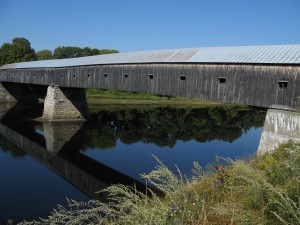 sunshine, Alex and I took a drive north to Waterbury for some ice cream, cheddar cheese, and chocolate tasting. Along the way we stopped to check out the world’s longest two-span covered bridge. The 450 foot Cornish-Windsor Bridge crosses the Connecticut River, connecting Vermont with New Hampshire. While I enjoyed the scenery along the state border, I really wanted to get deep into Vermont. Turning west we arrived in Waterbury at the Ben-and-Jerry’s-ice-cream factory. There was such a crush of people inside that we had to push our way through. Thankfully, we weren’t in the mood for ice cream so we pushed our way back out. We were in the mood for cheese samples, so we drove further down the road to Cabot Creamery. People were standing motionless around the long table filled with cheese samples. As I walked over to it eyeing some of the cheddar, a lady barked, “The line’s back there!” Alex and I went and stood in the unmoving line. A jovial employee was at the front of the line keeping order. Slooowly, the people who’d made it up to the sample table were picking up toothpicks, stabbing pieces of cheese, chewing, and then chatting with each other. Those of us in the back of the line glared at them, shooting toothpick darts with our eyes. How long does it take to taste cheese? About twenty minutes later, Alex and I arrived at the first plate of cheese. One spin around the table offers about twenty-five samples of cheese. By then we were full of cheese and ready for chocolate samples next door. When we walked in the door of Champlain Chocolates, we were warmly greeted with a small truffle. I found the bin of factory seconds and stocked up.
sunshine, Alex and I took a drive north to Waterbury for some ice cream, cheddar cheese, and chocolate tasting. Along the way we stopped to check out the world’s longest two-span covered bridge. The 450 foot Cornish-Windsor Bridge crosses the Connecticut River, connecting Vermont with New Hampshire. While I enjoyed the scenery along the state border, I really wanted to get deep into Vermont. Turning west we arrived in Waterbury at the Ben-and-Jerry’s-ice-cream factory. There was such a crush of people inside that we had to push our way through. Thankfully, we weren’t in the mood for ice cream so we pushed our way back out. We were in the mood for cheese samples, so we drove further down the road to Cabot Creamery. People were standing motionless around the long table filled with cheese samples. As I walked over to it eyeing some of the cheddar, a lady barked, “The line’s back there!” Alex and I went and stood in the unmoving line. A jovial employee was at the front of the line keeping order. Slooowly, the people who’d made it up to the sample table were picking up toothpicks, stabbing pieces of cheese, chewing, and then chatting with each other. Those of us in the back of the line glared at them, shooting toothpick darts with our eyes. How long does it take to taste cheese? About twenty minutes later, Alex and I arrived at the first plate of cheese. One spin around the table offers about twenty-five samples of cheese. By then we were full of cheese and ready for chocolate samples next door. When we walked in the door of Champlain Chocolates, we were warmly greeted with a small truffle. I found the bin of factory seconds and stocked up.
 As we drove up to Stowe, we commented that it would be a great day to have a beer at the newly opened Trapp Lager Brewery, owned by the von Trapp family of Sound-of-Music fame. But it was still morning and the leaves were glowing. The scenic road up the mountain at Stowe was so lovely I turned around so we could do it again. Then we headed south and turned east to take a long drive back across the state through the Green Mountains. When we saw an interesting backroad, we took it. We found the quiet beauty of Vermont in its farms and hilltop vistas. Near Ripton, we saw a sign for the Robert Frost Interpretive Trail. Frost was a summer resident of the village of Ripton and had five farms in Vermont. He considered himself a farmer first and a poet second. The interpretive trail takes people through the forest where displays of Frost’s poems can be read and pondered. So day went down to dusk and it was time for dinner. We celebrated our successful day of leaf peeping in Woodstock at Long Trail Brewing where I was starting to become a regular.
As we drove up to Stowe, we commented that it would be a great day to have a beer at the newly opened Trapp Lager Brewery, owned by the von Trapp family of Sound-of-Music fame. But it was still morning and the leaves were glowing. The scenic road up the mountain at Stowe was so lovely I turned around so we could do it again. Then we headed south and turned east to take a long drive back across the state through the Green Mountains. When we saw an interesting backroad, we took it. We found the quiet beauty of Vermont in its farms and hilltop vistas. Near Ripton, we saw a sign for the Robert Frost Interpretive Trail. Frost was a summer resident of the village of Ripton and had five farms in Vermont. He considered himself a farmer first and a poet second. The interpretive trail takes people through the forest where displays of Frost’s poems can be read and pondered. So day went down to dusk and it was time for dinner. We celebrated our successful day of leaf peeping in Woodstock at Long Trail Brewing where I was starting to become a regular.
On another weekend, I drove back up to Woodstock to visit the Marsh-Billings-Rockefeller National Historic Park. It was the first national park to focus on conservation. The site is a working farm that was originally owned by George Perkins Marsh. Reading the informational signs I learned that after the American Revolution, settlers poured into Vermont. There was an insatiable international market for wool, so forests were cut to make pasture and Vermont quickly had 1.7 millions sheep. By the 1860s ninety percent of Vermont’s forests had been destroyed. While a diplomat in the Mediterranean region of Europe, George Perkins Marsh saw that the devastation of land was long lasting. Europe was starting to devise forest management programs and Marsh felt that Vermont needed to do the same. He advocated a stop to clear cutting. Marsh moved away from his farm, and it was bought by Frederick Billings who had studied forestry. Billings used scientific methods to raise dairy cows and manage the forest on the property. Laurance Rockefeller, also a conservationist, married into the Billings family. Marsh and Billings were at the forefront of Vermont’s efforts to reestablish the wild lands that once covered the hills and valleys of the Green Mountain state.
On my final Sunday at the farm, the newly reopened Yagna Inn threw a party. Steve, Laurel, and I walked down to the bed and breakfast for an Indian dinner, an art and dance show, and a lighting of lanterns by the pond. We gorged on delicious Indian food which had been brought in by a restaurant in Massachusetts. We digested it while watching the  dancing, and then got directions on lighting the lanterns. I assumed we were lighting little boats to float in the pond; but no, these lanterns would float up into the sky. We were given detailed instructions on how to open the paper lanterns, place the candle on the wire holder, and then let go once the heat from the candle had inflated the lantern. They work like a hot air balloon. In the dark we went down to the pond with our lanterns, candles, and lighters. A few people knew how to do the lanterns. The rest of us fumbled along, needing help to keep our lanterns from burning up or catching ourselves on fire. I dropped mine in the grass after the flame got too close to my fingers. One group of college students cheered as their lantern rose into the air, and then gasped as it went into a tree. Instead of pondering the fire danger, it was best to look up and see the golden boxes take to the air, rising higher and higher in the sky. As they made their way away from us towards the interstate, someone commented, “Nine-one-one is probably getting calls of alien sightings.” It was the most fun I’d had in ages. The next day I saw Steve picking up spent lanterns on the property. Looking around I saw one in a tree and another in the forest off the side of the road. I’m sure Marsh and Billings would not have been pleased.
dancing, and then got directions on lighting the lanterns. I assumed we were lighting little boats to float in the pond; but no, these lanterns would float up into the sky. We were given detailed instructions on how to open the paper lanterns, place the candle on the wire holder, and then let go once the heat from the candle had inflated the lantern. They work like a hot air balloon. In the dark we went down to the pond with our lanterns, candles, and lighters. A few people knew how to do the lanterns. The rest of us fumbled along, needing help to keep our lanterns from burning up or catching ourselves on fire. I dropped mine in the grass after the flame got too close to my fingers. One group of college students cheered as their lantern rose into the air, and then gasped as it went into a tree. Instead of pondering the fire danger, it was best to look up and see the golden boxes take to the air, rising higher and higher in the sky. As they made their way away from us towards the interstate, someone commented, “Nine-one-one is probably getting calls of alien sightings.” It was the most fun I’d had in ages. The next day I saw Steve picking up spent lanterns on the property. Looking around I saw one in a tree and another in the forest off the side of the road. I’m sure Marsh and Billings would not have been pleased.
After a few weeks on the farm I was feeling out of my comfort zone. It wasn’t the way we were working, or even killing the goats: the austereness of the farm bothered me. The house was bleak with no decorations or adornments; work and staying busy were the order of the day. As one who values art, creativity, and aesthetics, I felt suffocated. I needed to leave. I fulfilled my one month commitment at Singing River Farm, and then moved on to another farm in Vermont for my last two weeks of WWOOFing before heading back across country to Seattle.

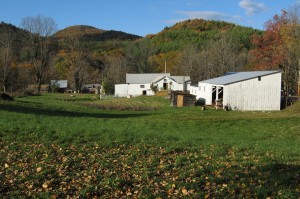

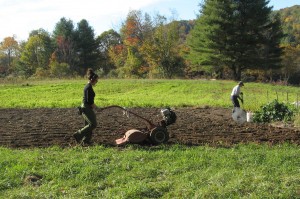


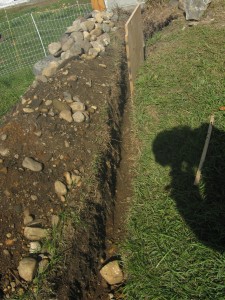
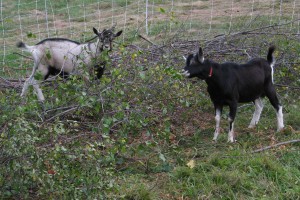

Reading your post was very helpful! I am an English teacher from Mexico and I am planning on visiting Steve and Laurel next year. I have been in touch with them through skype but am impatient to go visit!
Woofing is a dream of mine but I have been preparing everything in order to be able to leave. With a husband, two businesses and a toddler it is not easy. Thanks for sharing your experience!